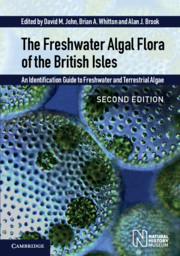 The Freshwater Algal Flora of the British Isles
The Freshwater Algal Flora of the British Isles Book contents
- Frontmatter
- Contents
- The online material (formerly provided in DVD format)
- List of Contributors
- Foreword
- Preface
- Acknowledgements
- Introduction
- Distribution and Ecology
- History of Freshwater Algal Studies in the British Isles
- Field Methods
- Laboratory Methods
- Water Framework Directive
- Cultures of British Freshwater Algae
- Classification
- Key to phyla
- Cyanobacteria (Cyanophyta)
- Phylum Rhodophyta (Red Algae)
- Phylum Euglenophyta (Euglenoids)
- Phylum Cryptophyta (Cryptomonads)
- Phylum Dinophyta (Dinoflagellates)
- Phylum Raphidophyta
- Phylum Haptophyta (Prymnesiophyta)
- Phylum Chrysophyta (Golden Algae)
- Phylum Xanthophyta (Tribophyta) (Yellow-Green Algae)
- Phylum Eustigmatophyta
- Phylum Bacillariophyta (Diatoms)
- Phylum Phaeophyta (Brown Algae)
- Primitive Green Algae (‘PRASINOPHYTA’)
- Phylum Chlorophyta (Green Algae)
- Phylum Glaucophyta
- Glossary
- Standard Form of Authors of Algal Names
- Sources of Illustrations or Material
- References
- Taxonomic Index
- Subject Index
- Plate Saction
- Miscellaneous Endmatter
- Miscellaneous Endmatter
Field Methods
Published online by Cambridge University Press: 12 January 2024
- Frontmatter
- Contents
- The online material (formerly provided in DVD format)
- List of Contributors
- Foreword
- Preface
- Acknowledgements
- Introduction
- Distribution and Ecology
- History of Freshwater Algal Studies in the British Isles
- Field Methods
- Laboratory Methods
- Water Framework Directive
- Cultures of British Freshwater Algae
- Classification
- Key to phyla
- Cyanobacteria (Cyanophyta)
- Phylum Rhodophyta (Red Algae)
- Phylum Euglenophyta (Euglenoids)
- Phylum Cryptophyta (Cryptomonads)
- Phylum Dinophyta (Dinoflagellates)
- Phylum Raphidophyta
- Phylum Haptophyta (Prymnesiophyta)
- Phylum Chrysophyta (Golden Algae)
- Phylum Xanthophyta (Tribophyta) (Yellow-Green Algae)
- Phylum Eustigmatophyta
- Phylum Bacillariophyta (Diatoms)
- Phylum Phaeophyta (Brown Algae)
- Primitive Green Algae (‘PRASINOPHYTA’)
- Phylum Chlorophyta (Green Algae)
- Phylum Glaucophyta
- Glossary
- Standard Form of Authors of Algal Names
- Sources of Illustrations or Material
- References
- Taxonomic Index
- Subject Index
- Plate Saction
- Miscellaneous Endmatter
- Miscellaneous Endmatter
Summary
Some of the larger freshwater algae can be identified in the field with the naked eye and rather more require the use of a hand lens (×10 or ×20), and sometimes fertile material can be recognized. However, most freshwater algae are microscopic and can only be identified using a reasonably good quality compound microscope. Small portable field microscopes are available, but are only suitable for identifying those algae for which critical microscopical examination is unnecessary.
Algae are generally most diverse and abundant during the summer and early autumn, but it is important to collect during different seasons as certain algal genera (e.g. Tribonema, Microspora) and groups (e.g. Chrysophyta) are more common at other times. Seasonality is therefore an important consideration when collecting in most aquatic habitats. Jane (1942) considered May to be best for collecting in some clear, soft waters near London, whereas June and July are good months in some Welsh lakes for ‘cold-water’ forms such as Dinobryon. In small ponds algal diversity is often greatest before the extensive development of aquatic macrophytes and the coming into leaf of shade-casting trees.
Aquatic algae
Macroalgae These can be collected by hand, wading in shallow water, and snorkelling or SCUBA diving in deeper water. Forceps are easier than fingers to gather small delicate specimens. A grapnel or dredge is required for attached macroalgae (especially charophytes) and other aquatic plants growing in water too deep to be sampled by wading. These plants should be collected because small algae may grow attached to them or be associated with any mucilaginous covering. A suitable collecting implement for remote sampling of macroalgae, such as charophytes, is a three-pronged grapnel fashioned from wire coat hangers suitably bent and a length of lead piping (Figure 1). Other sampling devices include a right-angled digging fork, a longhandled garden rake, or a scoop with a sharp edge and extending handle. These types of samplers may disrupt and cause damage to bottom-living communities. The conservation status of a site should therefore be considered before using them. In clear and shallow water it is possible to direct samplers to specific areas by viewing the bottom of the lake or pond using a glassbottomed bucket or diving mask. Thick mats of algae can be collected by hand, as can surface-floating mats of such algae as Oedogonium, Spirogyra, Zygnema, Mougeotia and Hydrodictyon.
- Type
- Chapter
- Information
- The Freshwater Algal Flora of the British IslesAn Identification Guide to Freshwater and Terrestrial Algae, pp. 14 - 18Publisher: Cambridge University PressPrint publication year: 2021


